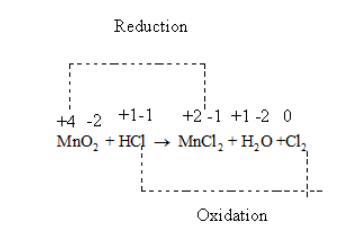
In the following reaction
Find
-Substance reduced
-Substance oxidized
-Oxidizing agent
-Reducing agent
Answer
484.5k+ views
Hint: Assign the oxidation number to all atoms. Oxidation is the loss of electrons while reduction is the gain of electrons. The substance which helps other species to get reduced and itself get oxidized is known as a reducing agent. While substance that helps other species to get oxidised and itself get reduced is known as oxidising agent
Complete Step by step answer: he redox reaction given to us is:
Using the oxidation number rules we can calculate the oxidation number of all atoms in the given reaction as follows:
The oxidation number of oxygen is always -2 except in peroxide. In peroxide oxidation number of oxygen is -1.
Using this rule we can determine the oxidation number of
Oxidation number of
So, Oxidation number of
Oxidation number of hydrogen is always +1 except in metal hydride it is -1.
Oxidation number of chlorine is -1 in most of the compounds.
Oxidation number of
So, oxidation number of
As oxidation number of
Oxidation number of
Oxidation number of an element is zero so oxidation number of

Thus, in the given reaction
So,
The substance reduce is
The substance oxidised is
The substance that is reduced acts as an oxidising agent while a substance that is oxidised acts as a reducing agent.
Hence, Oxidising agent =
Reducing agent =
Note: In the given reaction
Complete Step by step answer: he redox reaction given to us is:
Using the oxidation number rules we can calculate the oxidation number of all atoms in the given reaction as follows:
The oxidation number of oxygen is always -2 except in peroxide. In peroxide oxidation number of oxygen is -1.
Using this rule we can determine the oxidation number of
Oxidation number of
So, Oxidation number of
Oxidation number of hydrogen is always +1 except in metal hydride it is -1.
Oxidation number of chlorine is -1 in most of the compounds.
Oxidation number of
So, oxidation number of
As oxidation number of
Oxidation number of
Oxidation number of an element is zero so oxidation number of

Thus, in the given reaction
So,
The substance reduce is
The substance oxidised is
The substance that is reduced acts as an oxidising agent while a substance that is oxidised acts as a reducing agent.
Hence, Oxidising agent =
Reducing agent =
Note: In the given reaction
Recently Updated Pages
Master Class 11 Economics: Engaging Questions & Answers for Success

Master Class 11 Business Studies: Engaging Questions & Answers for Success

Master Class 11 Accountancy: Engaging Questions & Answers for Success

Master Class 11 English: Engaging Questions & Answers for Success

Master Class 11 Computer Science: Engaging Questions & Answers for Success

Master Class 11 Maths: Engaging Questions & Answers for Success

Trending doubts
Which one is a true fish A Jellyfish B Starfish C Dogfish class 11 biology CBSE

State and prove Bernoullis theorem class 11 physics CBSE

1 ton equals to A 100 kg B 1000 kg C 10 kg D 10000 class 11 physics CBSE

In which part of the body the blood is purified oxygenation class 11 biology CBSE

One Metric ton is equal to kg A 10000 B 1000 C 100 class 11 physics CBSE

Difference Between Prokaryotic Cells and Eukaryotic Cells




